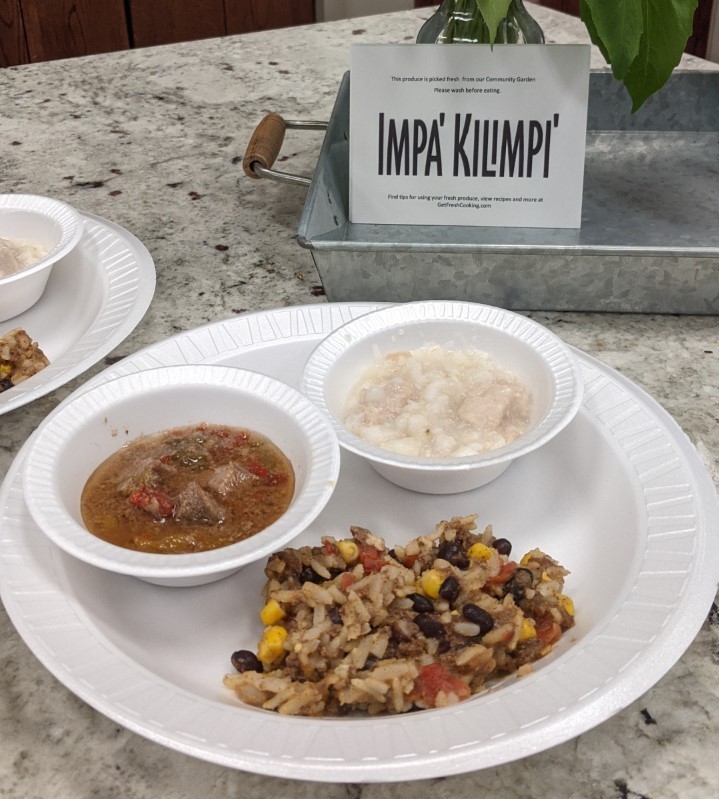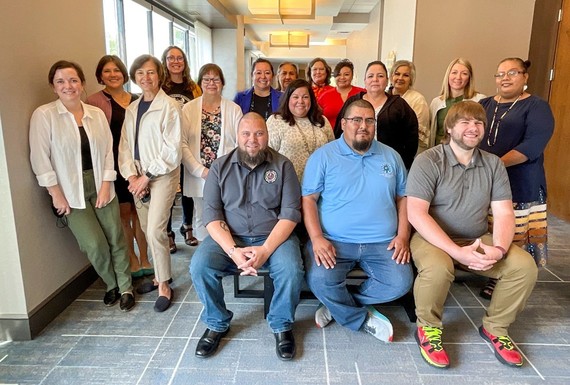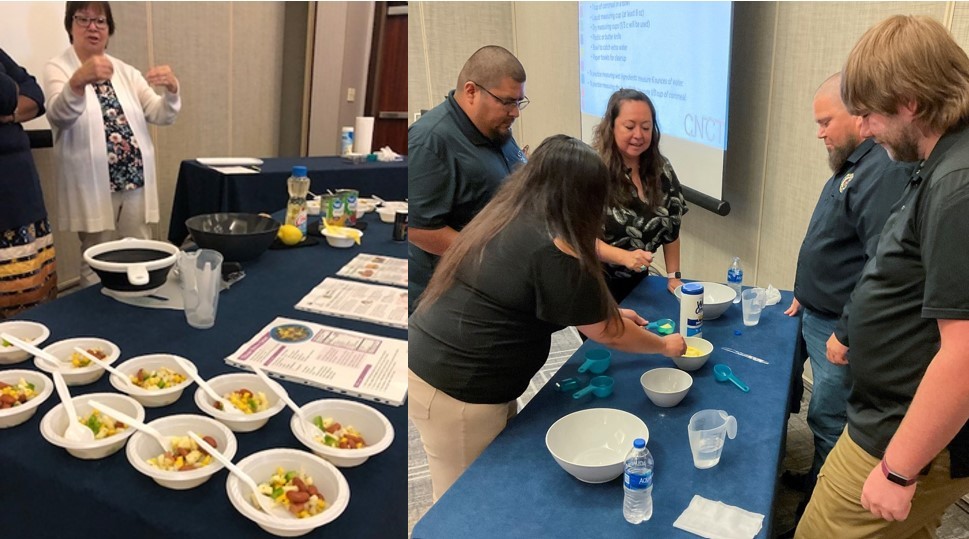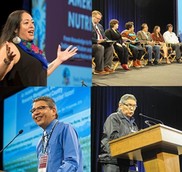 Chickasaw Nation food tasting promoted under Get Fresh!, an Impa’ Kilimpi’ (Strong Food) program using Tribally procured foods as part of FDPIR. Shown: taco rice skillet (ground beef), simple pepper steak (chuck roast) and pashofa (traditional hominy dish).
FDPIR Self-Determination Demonstration Project – USDA Support Continues!
In June 2022, USDA’s Food and Nutrition Service (FNS) finalized a series of contract modifications and extensions for Tribes participating in the FDPIR Self-Determination Demonstration Project. Through the demonstration project, eight participating FDPIR Tribes are able to select one or more foods that they would like to procure for inclusion in the FDPIR food package, identify the food(s) in the food package that they would like to supplant with their Tribally procured food(s), establish contract(s) with a vendor(s) to procure the selected food(s), and distribute the Tribally procured food(s) alongside other USDA-provided foods in the FDPIR food packages distributed to their Tribal members. In June, six of the eight participating Tribes requested and received extensions and/or modifications of their existing contracts originally awarded in October 2021. These extensions and modifications will allow them to distribute new foods or previously approved foods for additional months including: Alaska-grown potatoes, Alaskan cod, dry hominy, stew meat, pecans, and a variety of fresh produce including salad mix, radishes, summer and winter squash, onions, and cherry tomatoes.
To date, USDA has awarded $5.7 million dollars to Tribal Nations participating in the demonstration project. The six Tribes awarded the contract extensions and/or modifications include Oneida Nation, Menominee Indian Tribe, and Red Cliff Band of Lake Superior Chippewa from Wisconsin; Little Traverse Bay Bands of Odawa Indians from Michigan; Chickasaw Nation from Oklahoma; and Alaska Native Tribal Health Consortium from Alaska.
FNS staff recently visited Chickasaw Nation to tour their nutrition services facility in Ardmore, Oklahoma and see their Tribally procured foods being distributed to households as part of the FDPIR Self-Determination Project. Chickasaw Nation will be distributing five foods in total, including: chuck roast, ground beef, stew meat, dry hominy and pecans. All foods are procured from Native American vendors. During the visit, FNS staff met with Chickasaw Nation’s nutritionists who provided an educational food tasting of three of their five Tribally procured foods using recipes promoted under their Get Fresh! initiative.

Perk Up for Bell Pepper Season!
With summer upon us, we welcome red bell peppers to the mix of fresh produce offered through USDA DoD Fresh. Red bell peppers are a crunchy and sweet addition to the FDPIR food package. Three medium peppers equal one vegetable unit.
A few tidbits about red bell peppers:
- They are a delicious low calorie and fat-free vegetable;
- They can be eaten as a snack or added to meals;
- They are versatile and can be enjoyed raw, roasted, sautéed, or blended.
Their refreshing texture and sweet but mildly spicy flavor is a fan favorite - check out these recipes that highlight the different ways they can be used: stuffed peppers, eggplant and pepper dip, and bell pepper salad.
Did we mention the health benefits of red bell peppers? They are an excellent source of both vitamin A, great for eye and skin health, and vitamin C, an immune-system booster.
A fun fact about bell peppers is all bell peppers begin as green peppers. Green peppers eventually ripen to red peppers - the color of the pepper just depends on when it was harvested.
When using your red bell peppers, make sure to rinse and de-seed the pepper prior to cooking. Bell peppers should be stored in a cool or refrigerated area and used within 5 days for optimal freshness! Check out the USDA Foods Product Information Sheet for information on use, storage and recipes, and SNAP Recipes at MyPlate Kitchen for additional recipes!
|
Affordable Connectivity Program (ACP)
The Affordable Connectivity Program (ACP) provides eligible low-income households a subsidy of up to $30 per month on internet service plans offered by participating internet service providers and up to $75 per month for eligible households on Tribal lands. Eligible households can also receive a one-time discount of up to $100 to purchase a laptop, desktop computer, or tablet from participating providers if the household contributes more than $10 and less than $50 toward the purchase price.
Households with income at or below 200% of the poverty level are eligible for the subsidy—about 30 million households, or one in four of all households in the US. However, households are also automatically eligible for the ACP—without the need to prove their income—if at least one member of the household is receiving benefits from certain government assistance programs, including FDPIR.
The Biden-Harris Administration has secured commitments from many of the nation’s top internet service providers to offer high-speed internet plans to ACP-eligible households for $30 or less, with no other fees and no data caps. ACP-eligible households that choose to pair the ACP subsidy with one of these plans will be able to obtain high-speed internet with no out-of-pocket costs—meaning millions of low-income households will be able to obtain high-speed internet at no cost.

FDPIR Nutrition Education Paraprofessional Project
On June 23-24, 2022, the first FDPIR Nutrition Paraprofessional Training was held in Minneapolis, Minnesota. The training, which is known as the Community Nutrition Champion Training, was conducted by the Oklahoma Tribal Engagement Partners (OKTEP) through a cooperative agreement with USDA FNS. The goal of the training was to empower FDPIR partners to deliver nutrition education to FDPIR participants.
In 2018, a study was conducted to assess ITO staff interest in USDA-funded nutrition education training to provide ITO staff with the knowledge and skills needed to serve as nutrition paraprofessionals for their organizations. The findings indicated a nutrition paraprofessional training project was needed and would be supported. The study helped FNS understand what training topics would be of most interest and the best way to deliver the training.
The Community Nutrition Champion Training training covered ten topics including MyPlate, food safety, cooking basics, reading food labels, and a hands-on experience conducting a cooking demonstration. An important component of the training was weaving cultural connections throughout the training by sharing traditional language, stories, and practices when possible. Eleven tribal partners, representing each region, attended the 2-day pilot training. Attendees provided positive feedback, describing the training as “very informative,” “fun,” and “I hope this one is just the start of many more.”
FNS is currently working on a cooperative agreement that would allow OKTEP to conduct additional nutrition paraprofessional trainings in each region over the next three years. Check out the first cohort of FDPIR program staff at the Community Nutrition Champion Training in the pictures above and below!
Picture at the beginning of article, from left to right: Kelli Begay, David Halquist, Jr., Tanner Keller, Lacey Shipshee.
|
 Back Row: Rose James – Eastern Band of Cherokee Indians, Kelli Begay – OKTEP, Debbie Gardipee – South Puget Intertribal Planning Agency, Stephany Parker – OKTEP, Lacey Shipshee – Prairie Band Potawatomi Nation, Mary Dixon – Gila River Indian Community, Tiffany Grant – OKTEP
Middle Row: Sarah Kinney – FNS MWRO, Julie Skolmowski – FNS HQ, Tracy Fox – FNS HQ, Melanie Conners – Saint Regis Mohawk Tribe, Teresa Jackson – OKTEP, Audrey Estes – Lower Brule Sioux Tribe, Kyra Cuthair – Ute Indian Tribe
Front Row: David Halquist, Jr. – Pokagon Band of Potawatomi, Kyle Autaubo – Kiowa Tribe, Tanner Keller – Little Traverse Bay Bands of Odawa Indians
Not pictured: Rolanda Laducer – Spirit Lake Tribe
 Upper Left: Melanie Conners.
Upper Right, from left to right: Lacey Shipshee, Kyle Autaubo, Kelli Begay, David Halquist, Jr., and Tanner Keller.
 Upper Left, from left to right: left to right: Melanie Conners, Kyra Cuthair, and Debbie Gardipee.
Upper Right, from left to right: Kyra Cuthair and Debbie Gardipee.
Pyramid Lake Paiute Tribe Begins Distributions
In September 2021, FNS formally approved the Pyramid Lake Paiute Tribe’s application to administer FDPIR in their near area which includes households living in Nixon, Sutcliffe, and Wadsworth, Nevada. Since September, the Tribe finalized renovations to their FDPIR warehouse, hired staff, and worked with the Nevada Department of Agriculture to transition households from the state-run FDPIR to Pyramid Lake’s program. In April 2022, Pyramid Lake officially opened their doors and started distributing food to FDPIR participants.
FNS staff from the Western Regional Office recently talked with Bonnie Smith, Director of the Pyramid Lake Food Distribution Program, about her lessons learned over the past few months. Ms. Smith shared that the program has been steadily growing since its first distribution. In April, they started with just a few families participating, but they are now up to 25 active households and they have been hearing from more people with interest in the program. Ms. Smith reported that supply chain issues and the cost of goods were a challenge, which led to delays in getting their warehouse stocked. They have also dealt with growing pains along the way, from the challenges of distributing food with COVID protocols in place, to learning how to effectively pre-pack loose produce such as oranges and lemons for distribution. Overall, they are excited to be up and running though, and she shared the following initial successes:
- The first distribution was made within nine months of writing the grant and preparing the warehouse facility.
- Community members know about the program, and they show appreciation for it.
- Community members have food throughout the month, leading to more stability at home, work, and school.
- Our elder and disabled home delivery program is slowly expanding. More and more often these days, I am hearing from people who have to decide if they are going to buy food for the family or save the money to purchase gas to get to/from work. Providing these foods allows, in some cases, MAJOR stress relief!
FNS congratulates Bonnie Smith and the rest of the FDPIR team at Pyramid Lake on all of their hard work to set up the program, including the application, first distributions, and beyond!
Certification Chatter
For this month’s Certification Chatter, we are going to take a step back to remind everyone of a great resource for getting all of your certification questions answered - the FDPIR Household Certification Training course. FNS developed this course to help ITO and State agency certification workers and their supervisors to successfully administer the program. The course covers the nuts and bolts of FDPIR certification rules, and it is both a valuable initial training for those new to the program and a great refresher for those who have worked on the program for several years. The course can be accessed online here: FDPIR Household Certification Training Course.
As always, if you have a certification question that you’d like us to feature in the newsletter, or if you have any certification questions in general, please reach out to your FNS Regional Office Point of Contact.
FDPIR: Clarification on Eligibility of Lineal Descendants
FDPIR federal regulation at 7 CFR 253.6(b)(1) states “All Indian Tribal households in § 253.2 which reside in near areas established under § 253.4(d) shall be eligible to apply for program benefits.” Furthermore, the 253.6(b)(1) states, “The ITO or State agency administering the program in a near area shall, for purposes of determining program eligibility, accept documentation from a household member’s Tribe of origin as proof of Tribal membership.”
Acceptable forms of documentation to determine Tribal membership includes the following:
1. An official card, letter, or other documentation issued by an Indian Tribe which indicates that the individual is a tribal member.
2. An official Certificate of Degree of Indian Blood or Certificate of Degree of Alaskan Blood (both abbreviated CDIB) card.
3. An official document (letter, memorandum, form, etc.) from a Bureau of Indian Affairs office or a Tribe/Nation which states the individual named in the document is the direct descendant (son, daughter, grandchild, etc.) of a federal-recognized member.
Additionally, each FDPIR administering program should delineate this in their Plan of Operation and ensure any corresponding materials such as application forms, brochures, websites, etc. provide accurate information on proof of Tribal enrollment. These materials should not state, for example, that a CDIB card is required.

May 2022 Native American Nutrition Conference
The fifth annual Native American Nutrition Conference was held May 23-25, 2022, in Prior Lake, Minnesota, with a virtual attendance option. The conference is dedicated to the food and nutrition of Indigenous Peoples.
This year’s theme was “Decolonizing and Indigenizing our Diets for Health” and sessions highlighted returning to traditional diets, indigenizing nutrition and food policy, and food sovereignty. USDA provided an update on supporting access to nutritious traditional foods through USDA nutrition programs. The session was followed by a presentation providing the tribal perspective on the Food Distribution Program on Indian Reservations (FDPIR) given by the Midwest Region President of the National Association of Food Distribution Programs on Indian Reservations (NAFDPIR).
In Case You Missed it (ICYMI): Check-out the conference videos!
|
New Validation Tools in WBSCM
With the June release, the Web-based Supply Chain Management (WBSCM) system will introduce new validation processes to help users avoid data entry errors.
- While receipts are submitted, WBSCM will check the total receipted quantity against the expected shipment quantity from the Advanced Shipment Notification and the Purchase Order. If the amount entered is outside of the tolerance range (+/- 10% for most materials), users will be prompted to check their entry and try again or contact the WBSCM Service Desk for assistance if the out-of-tolerance quantity is accurate.
- WBSCM will only accept a goods receipt that has a total receipted quantity greater than zero; if the good quantity is zero, then rejected and/or damaged quantity must be entered. When a user enters zero good quantity, they will be prompted to confirm that they have entered values correctly before submitting.
- Sales order transactions should not allow the user to select an inactive Ship-To organization. Currently, WBSCM has validations in place for new requisitions and sales orders. With this release, validation will ensure that inactive Ship-To organizations are not added through uploading sales orders, while reviewing and consolidating requisitions, or during FNS’s processes for mass sales order updates and approvals.
All monthly changes are documented in the Release Notes, which may be accessed in WBSCM at Help > Training > Release Notes.
Stay tuned this summer for the FNS WBSCM Annual User Validation exercise. Users who have not logged in within the last 9 months will be deactivated. Please log in to WBSCM at your earliest convenience to keep your account active.
For questions about WBSCM, please contact the WBSCM Service Desk or call (877) 927-2648.
|